|
| Book Transcription |
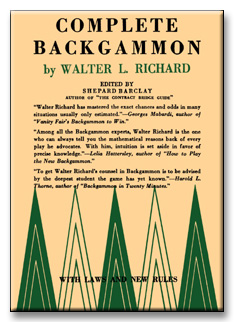
|

|


Introduction
One of the treats of life is to know a leader in any game. In former years, as a sporting editor, it became our privilege to rub elbows with the commanding figures of golf, tennis, football, billiards, and other forms of competitive endeavor. Later came intimate association with every man and woman who has gained world distinction in auction and contract bridge. But of all these we have known none who has conducted exhaustive research into his game in quite the same way that Walter L. Richard has done with backgammon.
What an anachronism it is to find a pioneer explorer in a field so ancient as backgammon, which was already an old game in the time of Chaucer! Through centuries, backgammon has waited with its unsolved mysteries. Now Walter Richard has delved into them and as a result has blazed new trails. He has proved many accepted ideas unsound and many customary moves to be contrary to the best interests of the player. He has figured out the better ones. He has charted the course of action in situations hitherto solved only by the intuition of the player, or lack of it. He has made it possible for the student of the game to know just what to do in many cases which previously involved estimating.
The love of this fascinating game which caused him to make such a study of it has also been his impelling force in winning converts to it from other games. It is safe to say that he has done more than any other person to popularize backgammon and make it a reigning vogue in American social circles. Those who are now devoted to the game because of his direct personal contact and enthusiasm can be numbered in the hundreds, and those whom they influenced are well among the thousands. Even some of the most prominent professional instructors were initiated into the mysteries of backgammon by him, and they whole-heartedly acknowledge the part he has played in their careers.
Mr. Richard’s interest in the game first became keen years ago while he was a player in a prominent club in Paris, where many of the best European experts congregate. While in Europe his penchant for organization asserted itself, and he arranged a number of tournaments. He also conducted the first regular tournament in this country among members of well-known clubs, a meeting which was so successful that it was followed by his formation of an inter-club league for periodical competition among teams of members of leading clubs in New York.
Mr. Richard has been an energetic influence in clarifying the rules of the game. Now he has drawn up suggested additions to the code logically covering every reasonable contingency. They occupy a space in the back of this book — the first thorough regulations in existence.
Once in a great while, in any field of endeavor, a book comes out which upsets previous ideas, proves the old order to be based on “false truths,” and alters the general attitudes. That was so with whist and bridge at several stages in their development. And this book is certain to do likewise in its field.
Incidentally, the editing of it and the intimate contact with the author during that process have been a decided pleasure.
Any player who goes carefully through this book will find its advice profitable when he goes to the game table to apply it.
After “resisting the impulse” to write a book until the demand of his friends had become too insistent for him to refuse, Mr. Richard now offers it — to my mind, a masterpiece of thoroughness and accuracy. It is to be commended to all interested in the game. The neophyte will benefit greatly from it, while the experienced player will readily understand why it deserves its title of “Complete Backgammon.”
Editor.

Foreword
The fact that one writes such a book as this about a game proves the degree of his interest in his subject. It would therefore be superfluous for him to say what a wonderful game he considers backgammon to be.
This book is not intended in any sense to be literature. Its purpose is intensely practical. It is meant for both beginners and experienced players who wish to become truly proficient. For those who already play, it is intended to help correct errors, furnish a new outlook and give a comprehension of factors not previously analyzed. For beginners, the general description of backgammon and its equipment, together with definitions of technical terms, will be found at the end of the book. The reading of that will give them the necessary foundation and prepare them to make full use of the rest of the book. Thus, regardless of what may be the starting point of the reader — whether “from scratch” or from a more advanced stage — the objective is a complete and thorough understanding of the game.
Backgammon is a contest in mathematics. Throughout the progress of a game, the laws of mathematical chances, probabilities, permutations, etc., operate inexorably in the long run. The one who wins is he who most intelligently employs the law of averages, and the loser is he who finds the probabilities working against him because he does not understand them.
The chances and odds governing various problems of the game are presented first. Next will be found the author’s advice regarding different moves, beginning with a complete set of opening moves, following with the first responses to the various openings. From there on the treatment is largely chronological, the problems being dealt with, as far as possible, in the order in which they occur, right up to the final moment when the game has been won and lost.
This book cannot enable anyone to become a real backgammon player without practice. Nor can any book. It has been said that no music teacher can “teach a pupil to play the piano,” that all he can do is “show the pupil what to practice so that the pupil may teach himself by practicing.” My fondest wish on behalf of my readers is that they will practice at every opportunity, not only when they have a chance to play with someone but also when time is available to get out the board, the men and the dice, and play both sides of a game themselves. For the player who will do this, thus fixing in his mind what he studies and learning the application of it, success in the game is a practical certainty.

Note for Beginners
Complete Backgammon is arranged differently from other books on games.
Beginners will find a complete description of the game in the back of the book [starting at the section “For Beginners”]. After that has made them Players, they will be ready for the advice on the most efficient tactics, with which the book begins.
Players, already familiar with what the game is, will read the book in the regular order — from front to back — omitting the part in the back for Beginners.

General Instructions
Everything in this book will be understood more clearly if the reader studies it with a backgammon set at hand. If he will place the men in the various situations considered, he will be able to fix each bit of information or suggestion in his mind.
Those familiar with other books on backgammon will be surprised to find in this book only one diagram of the board. It serves as the frontispiece and is again printed on a card that can be found inside this volume, thus making it especially serviceable for reference. The various parts of the board, and the different points along the table, whenever mentioned, may be readily located by looking at the diagram. It also shows the set-up for the start of a game.
General explanation of the game will be found in the back of the book for the benefit of beginners. The laws of the game also are there.

Luck vs. Skill
Whenever a bridge beginner holds every ace, king, and queen, he usually defeats the most expert opponents. Likewise, whenever a backgammon newcomer is favored with an astonishing succession of advantageous dice throws, he can conquer the greatest player that ever lived. Such occurrences cause the player of any game to wonder what is the proper proportion between skill and luck as deciding factors — 80 per cent against 20, or what?
There is one, and only one safe answer to such a question: When luck is even, the outcome depends 100 per cent upon skill; when skill is even, the result depends 100 per cent upon luck.
Over a long enough period each player theoretically gets an even break of fortune in the dice throws. Nothing in the world is more dependable than the law of averages. It is fickle in the way it swings back and forth, but always makes up later for its idiosyncrasies. The player therefore should base all of his backgammon moves and calculations upon the assumption that on any occasion the chances favor his getting exactly as good throws as the law of averages indicates — no better and no worse. He will be sorely disappointed at times in his expectations, but his chagrin will be offset eventually by the better-than-average fortune encountered at other times, unless he is one of those unfortunates who cannot recognize their share of good luck and therefore consider themselves “unlucky.”
While it thus becomes manifest that in my opinion the moves in backgammon should be made along those lines that are indicated by mathematical probabilities, I am perfectly ready to recognize that there are persons who believe in luck as an element having a preponderant influence in all human affairs. If, therefore, a player wishes to go against mathematical probabilities, feeling that it is a lucky thing to do, and prefers to risk a lucky possibility, I see no way to pursue an argument with him that will bring us nearer together in our theories of play.

General Tactics
Backgammon is, when clearly understood, essentially a game of escape or retreat. It should always be firmly borne in mind that the two men on the opponent’s inner table should be started on their way as soon as possible in order to prevent their being blocked. This makes way for the freedom of movement necessary for effective exercise of strategy.
For this reason even the opening moves as given later in this book are different in almost every case from those in any book hitherto published. The moves here given are based on the imperative need of escape, whereas most books stress strategy in really secondary matters without giving due consideration to the chances taken.
Of paramount importance to the player is an accurate knowledge of the odds in the various circumstances that arise, not alone the chances of hitting a blot a given number of points away — as printed in nearly all books — but practically every mathematical chance of any other nature which occurs during a game. It is for this reason that the author has calculated, and now presents, a comprehensive set of figures. The player with a special knowledge of these figures need only apply them with intelligence to have a decisive advantage over his opponent whose plays are contrary to the mathematical chances.
The vast majority of backgammon players make their moves by intuition. Beginners invariably place their men as often as possible on safety spots. More experienced ones distribute their men in order to be able to be in better position to make points, but few of them, even though experienced, are thoroughly familiar with the odds, and thus the risks they are taking.
A great number of players have been tested with two simple questions:
- What are the chances of a man on the bar being entered when the opponent has only one point in his inner table covered? The answer almost invariably is 5 out of 6, or 5 chances to 1. The correct odds are really 35 to 1.
- What are the chances of a man on the bar being entered when the opponent has 3 points in his inner table covered? The answer almost invariably is 3 out of 6, or even. The correct odds are really 3 to 1.
Additional questions repeatedly asked, which receive practically nothing but incorrect answers, are:
- In bearing, one’s opponent has a man left on the 1-spot. You have two men still to bear, one on the 1-spot, one on the 6-spot. Would you double?
- Again, you have one on the 1-spot and one on the 5-spot. Would you double?
The correct odds on the former are 4 to 3 against bearing both men, and on the latter 7 to 4 in favor of your bearing both. Knowing these odds, you know how to answer the questions concerning the advisability of doubling.
Questioning of countless players has succeeded in locating only a very few who could quote the odds on many of the most important plays that come up. This no doubt is because of the natural human tendency to guess in preference to expending the effort necessary to calculate the exact odds. Now that this work has been to some considerable extent done, there will be no further excuse except inertia for failure to know the odds presented on the pages that follow. In order to render the odds easier to memorize, some of them are given approximately instead of in minute percentages.

Chances and Odds
Combinations of the Dice
There are 36 different combinations possible in the throw of the dice, as follows:

It is obvious, of course, that there is only one way to throw any so-called “doublet,” such as 3 on each die, but that there are two ways to get any other throw, such as a 4 and 2, by means of a 4 on the first die and a 2 on the second, or a 2 on the first die and a 4 on the second. Thus any given doublet occurs only one-half as often as any other one throw. Therefore the chances of throwing any specific combination except a doublet are 17 to 1 against, and for any particular doublet 35 to 1 against.
To determine the average throw, one must add all of the numbers of the 36 possible throws on the dice as given, and in addition add the value of the doublets a second time as they count double. This makes an aggregate of 294, which divided by 36, shows that the average throw of the dice totals exactly 81/6 .
Anyone with sufficient patience can place men on the table in any position and figure the odds by keeping in mind the various possible throws as given and noting how many of the 36 can be used for any specific purpose.
The table directly following will give the approximate odds of throwing all of the numbers possible with two dice.
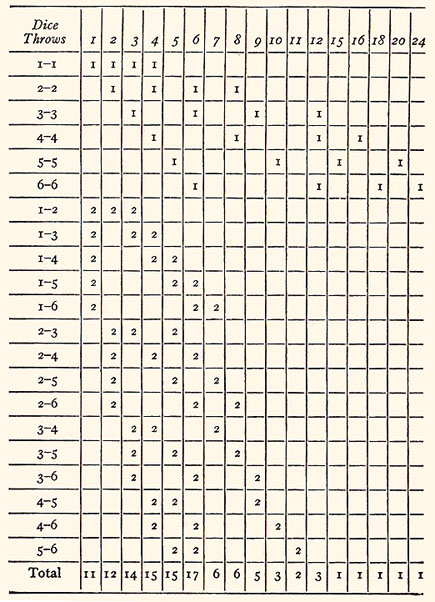
In the figuring of the above table, doublets, it will be remembered, can be thrown in only one way, but all other combinations can be thrown in two ways, therefore doublets are figured singly and the other combinations two ways.
As there are 36 combinations of the dice, a 2, for example, as per above table, can be thrown 12 ways out of 36, or 24 to 12 against throwing a 2, which is 2 to 1 against. An 8 as per table can be thrown 6 ways out of 36, or 30 to 6, equivalent to 5 to 1 against.

Chances of Hitting a Blot
(a) With no points of opponent intervening.
When none of the intervening spaces is occupied by an opponent’s point, the chances of hitting a particular blot are as follows:
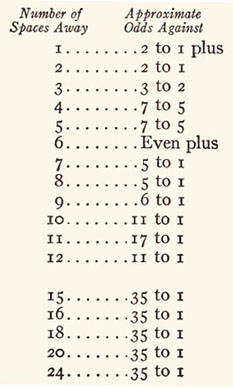
(b) With points of opponent intervening.
It will be astonishing to most players to learn that the chances of hitting a blot are only slightly diminished by the existence of opponent’s intervening points if it happens that even one space is still open. The extremely small variation of the odds in such cases is a revelation to anyone who figures them out for himself. There are too many different combinations in the placing of opponent’s intervening points to give a detailed table covering them all. The following, however, are dependable approximate average percentages:
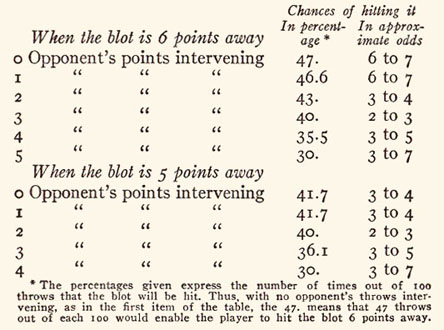
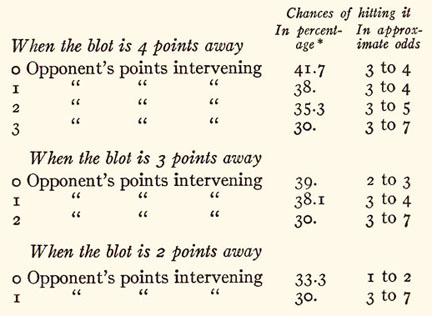
When all intervening spaces are closed there are always 11 chances out of 36 to hit a blot as far as 6 spaces away, which is equivalent to odds of 11 to 25, 1 to 2¼, or a 30 per cent chance.
Chances of hitting a blot with one of two men on different points not over six spaces distant:
Average 2 to 1 it will be hit.
There are 15 possible combinations whereby two men can be within 6 spaces of a blot. The chances of hitting the blot under these circumstances range from 3½ to 1, down to 5 to 4, averaging 2 to 1.
Men on the Bar
The chances of entering one or more men from the bar, and the chances of hitting an opponent or opponent’s man with such men, vary of course according to the situation, as follows:
Chances of entering one man from the bar:

Chances of entering 2 men simultaneously from the bar:

Chances of man on bar entering and hitting one blot on opponent’s inner table:
Average 3 to 2 against hitting it.
(If opponent’s inner board is entirely filled with points with the sole exception of the space occupied by the blot, the odds are 2¼ to 1 against hitting it.)
Chances of hitting opponent’s blot on any point in his inner table when you have a man on the bar and another on a lower point in his inner table:
Average 5 to 4 he will be hit.
Chances of man on bar entering and hitting one of two blots on opponent’s inner table:
Average 5 to 4 he will hit one of them.
Chances of Bearing
When the end of the game stage has been reached, with both players bearing and the opponent in such a position that he will be certain to have his men off on his next throw, it is important for the player who also has two men remaining to know the odds of bearing both his men. They are as follows:
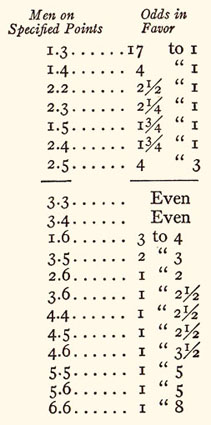
The above odds show conclusively that the first seven combinations are in the player’s favor. When in any of these positions, the offering of an immediate double is of course advisable.
Doubling
It is obvious that a player should double whenever he has a substantial advantage over his opponent, but no emphatic prospect of a gammon. Such a situation may come early in the game, in mid game, or in the latter part of the game. The fortunes of war can shift suddenly in backgammon. A succession of throws of a certain type may cause a player to find himself engaged in an aggressive running game, the defensive back game, or perhaps even in possession of a side prime. In any of these circumstances, if it develops that he has his opponent at a distinct disadvantage, it is in order for him to double. It is therefore highly important for a player to know in all situations how to figure whether he is really ahead or behind.
Accepting of Doubles
It is plain that when a player doubles, he is undertaking an additional even proposition, and therefore requires a clear-cut advantage over his opponent to make the double sound. But the player accepting a double is not actually accepting an even proposition, he is really receiving 3 to 1 odds from his opponent.
This is not difficult to understand once it is explained. If the player refuses the double and gives up the game he immediately loses 1. Should he, however, accept and win, he wins 2, which makes him 3 better off than he would have been if he had refused the double in the first place. Thus, in exchange for an opportunity to be 3 richer, he risks only an additional 1, so that he is accepting a 3-to-1 proposition.
Should it develop, though, that the player accepting the double loses a gammon, he would lose 4, and thus 3 in addition to the 1 he would have lost had he not accepted the double. The odds in this case, therefore, in accepting, would be 3 to 3, or even.
Should the accepting player lose a backgammon, he would lose 6, and thus 5 in addition to the 1 he would have lost had he not accepted the double. So the odds in that case — standing to be 3 better off or to lose 5 in addition to the 1 conceded — because of his accepting would be 3 to 5 or 12/3 to 1 against him.
Opposed to the danger of losing gammon or backgammon, however, is the acceptor’s “fighting” chance of perhaps winning one of them himself, through unexpected shifts of fortune. In addition, his acceptance gives him the right to offer the next double.
It should therefore be evident that doubles should always be accepted when the game is at all close or when a player has a strategic position for a good back game.
Running Game
When all of the opponent’s men are practically sure to pass yours and all of yours are practically sure to pass his — or if both sides have passed each other — backgammon develops into a running game. It is then important, from the standpoint of doubles and their acceptance, to be able to tell which side is ahead. This then comes down to the question of the chances of each side entering its inner board.
A quick way of figuring this is as follows: men on the player’s outer table count one each, his men on opponent’s 12-point count 2, those further on opponent’s table count 3. By reversing, counting the position of the opponent’s men in the same manner and then comparing, the player can immediately tell who is ahead. If it is close when figured this way, at comparison of the condition of each player’s inner board becomes of the utmost importance — that is, the specific location of his men thereon.

The Moves To Make
Opening Moves
Obtaining the jump on the opponent is important in backgammon. Doing this depends of course partly upon the way the Fates express themselves in the opening throw of the dice. In the long run, however, the player may hope to receive an even break of fortune; and therefore the question of whether he is a good starter or a poor one hinges upon his ability to make the most of each throw. The very best use of initial throws, as figured out scientifically, is as shown below.
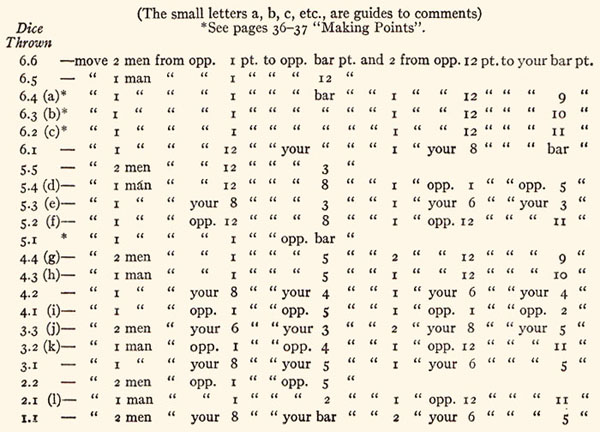
Comment on Opening Moves
- To move one man from opponent’s 1-point to his 11-point gives him a 1-to-2 chance to send you home and make you lose 11 pips, with no chance to hit his possible blot.
Should you move one man from your 8-point and one from your 6-point, making your 2-point, you are too far forward on your table.
- To move one man from opponent’s 1-point to his 10-point gives him a 2-to-3 chance to send you home and make you lose 10 pips, with no chance to hit his possible blot.
- To move one man from opponent’s 1-point to his 9-point gives him a 5-to-7 chance to send you home and make you lose 9 pips, with no chance to hit his possible blot.
Should you move one man from opponent’s 12-point to your 5-point, you take an unnecessary chance of 5 to 7 of being hit, thereby losing 20 pips. The chance of not being hit and making this important point does not justify the risk.
- To move one man from opponent’s 1-point to his 10-point gives him a 2-to-3 chance to send you home and make you lose 10 pips, with no chance to hit his possible blot.
Should you move one man from opponent’s 12-point to your 8-point and one man from opponent’s 12-point to your 9-point, you add a builder, but fail to aid in the escape of a man from your opponent’s 1-point.
- To move one man from opponent’s 12-point to your 5-point involves an unnecessary chance of 5 to 7 of being hit, thereby losing 20 pips. The chance of not being hit and making this important point does not justify the risk.
Should you move one man from opponent’s 12-point to your 8-point and one man from opponent’s 12-point to your 10-point, you add a builder, but fail to make the 3-point on your board; this point is rather advanced but should be made.
- To move one man from opponent’s 12-point to your 8-point, and one man from opponent’s 1-point to his 3-point, would of course advance a man toward escaping, but would weaken your own position; when men are stacked on two points, a builder is of great value, hence the play of one man from opponent’s 12-point to your 11-point.
- To move two men from opponent’s 12-point to your 5-point establishes a most valuable point, but overlooks the escape of the two men on opponent’s 1-point.
Should you move two men from opponent’s 1-point to opponent’s 9-point, you are on your way to escape but have few safety spots on your outer table to move to, and besides you give up an important point on your opponent’s table.
- To move one man from opponent’s 12-point to your 9-point and one man from opponent’s 12-point to your 10-point gives you two builders, but you are taking a 1-to-2 chance of having one of these blots sent home, thereby making you lose 15 or 16 pips.
Should you move both men, forward from opponent’s 1-point to aid in their escape, you allow the opponent too much freedom of movement in his inner table and pass up the opportunity to place a valuable builder in your outer board.
- To move one man from opponent’s 12-point to your 8-point, adds nothing to your position.
Should you move one man from opponent’s 12-point to your 9-point, and one man from your 6-point to your 5-point, you are taking unnecessary chances of 5 to 7 and 1 to 5 respectively, or about even that one blot will be hit, and a 1-to-17 chance of having both blots hit. If not hit, your chances of establishing your 5-point are considerable, but the risk is not justified.
- To move two men from opponent’s 12-point to your bar-point establishes an important point, but to immediately have a 3-point board is preferable.
Should you move two men from your 8-point to your 5-point and two men from opponent’s 1-point to his 4-point you start escaping but have not three points established in your inner board.
Should you move two men from opponent’s 1-point to opponent’s bar-point, you escape temporarily and keep your opponent from establishing his bar-point, but you are on a point from which it is difficult to escape with both your men.
Should you move two men from opponent’s 1-point to his 4-point and two men from opponent’s 12-point to your 10-point, you have begun to escape and have added builders, but you have failed to take advantage of the opportunity to establish your most valuable point on your board.
- To move one man from opponent’s 12-point to your 10-point, and one man from opponent’s 12-point to your 1 1-point, gives you two builders, but you are taking a 1-to-4 chance of having one of these blots sent home, making you lose 14 or 15 pips.
Should you move one man from opponent’s 12-point to your 8-point, you are not improving your position.
Should you move one man from your 8-point to your 5-point and one man from your opponent’s 12-point to your 11-point, you are taking unnecessary chances of 5 to 7 and 1 to 17 respectively, and a 1-to-17 chance of having both blots hit. If not hit, you have a chance to establish your 5-point, but the risk is not justified.
To move one man from opponent’s 1-point to his 4-point, would pass up the opportunity to place a valuable builder in your outer board.
Should you move one man from opponent’s 12-point to your 10-point you would be taking a 1-to-7 chance of being hit instead of a 1-to-17 chance had you placed the man on your 11-point as advised.
First Responses to Opponent’s Opening Moves
It would be patently impracticable to present advised moves for every possible throw in response to every possible throw by the opponent. That would involve a matter of 36 times 36 different combinations. The more important ones, however, are covered below: (The small letters a, b, c, etc., are guides to comments following.)
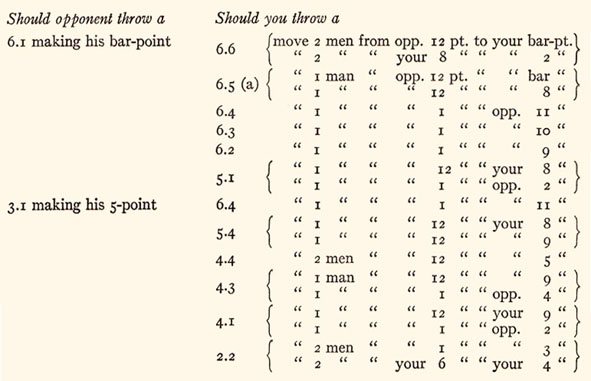
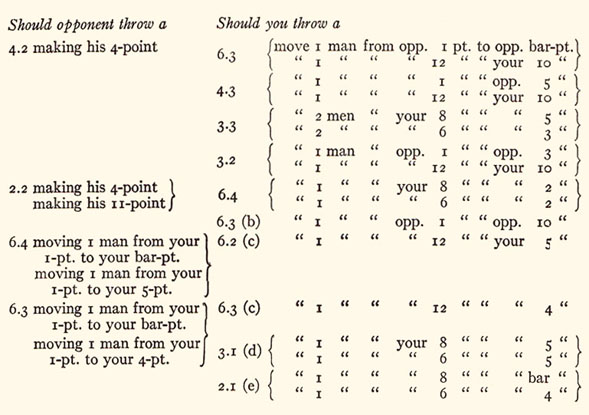
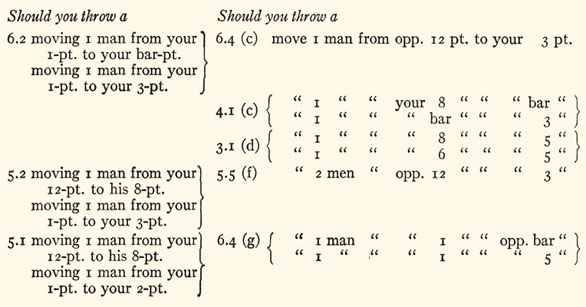
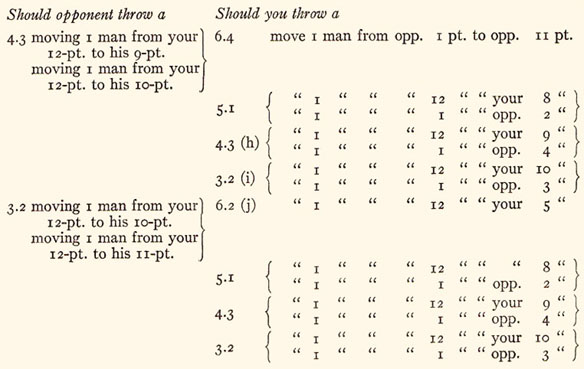
Comment on First Responses
- The only other plausible play is to move a man from opponent’s 12-point to your 2-point. Should you do this, the chances are less of being hit, but being hit you lose the value of the entire throw, whereas if hit on the bar-point you have saved the 5 pips the other man has advanced, and in addition, should your blot on your bar-point not be hit, you will in all probability manage to fill your bar-point.
- Should you play a man from opponent’s 12-point to your 4-point, the odds are 3 to 2 against your being hit; but if you are hit you lose 21 pips. If you move as per the advice given, the odds are 5 to 4 you will be hit, but if you are, you have then lost only 10 pips and besides have had the chance to escape with one man.
- In taking up opponent’s two blots the chances are 2 to 1 that he will enter his two men the next throw, but 2¼ to 1 that he will not hit you. The odds are better than 3½ to 1 that you will be able to cover and make a point the next throw.
- Instead of hitting your opponent’s two blots and taking a 1-to-2¼ chance of your blot being hit upon the reentry of the opponent, it is better to make your most important point, your 5-point.
- This is a very poor throw and can be used in no way to any advantage except in sending both men home. You take a 1-to-2¼ chance that your blot will be hit upon the reentering of your opponent, but, should it not be hit, you undoubtedly will make a point.
- Should you take up both opponent’s blots on your 3-point and 1-point and make 2 additional points on your board, the odds are 3 to 1 against your opponent entering both his men simultaneously; however, you have weakened your position considerably by being too advanced at this stage of the game. It nevertheless remains true that, if your opponent throws badly and you throw well on the next two or three casts, you then would have an excellent chance to win a double game.
- To take up opponent’s blot on your 2-point, thereby establishing another point on your board, is a bad play; you are too advanced and the odds are 8 to 1 that your opponent will enter immediately. To move one man to your opponent’s 11-point would make you risk losing 11 pips.
- The odds are 2 to 1 that the opponent will not take you up and make a point on his board. In addition, the man played to your 9-point is safe against any throw except double fours, as, if the blot is hit, you would have chances at three of your opponent’s blots.
Both men should not be advanced from opponent’s 1-point, as that would give him too many chances to send you home and at the same time make a point.
Should you play one man from opponent’s 12-point to your 9-point and one man from opponent’s 12-point to your 10-point, the odds are 2 to 1 that you will not be hit, but if you are hit you lose 15 or 16 pips and also may have lost an opportunity to escape with one of your men from opponent’s 1-point.
- The one man is advanced two points rather than three as the opponent has less chance of hitting the blot and making a point. The total of 3-2, or 5, if played from the opponent’s 12-point to your 8-point, would not strengthen your position.
Should you move two men from your opponent’s 12-point to your 10- and 11-points, you take too much risk of being sent home, thereby making you lose either 14 or 15 pips, in addition to which you will have lost the chance to start either of your men in escaping from your opponent’s 1-point.
- In playing one man from opponent’s 12-point to your 5-point, you are taking a 5-to-7 chance of being hit; if not hit you have a good chance of establishing your most valuable point. The only other plausible play would be to advance a man or men from opponent’s 1-point; the advanced man, however, would be almost certain to be sent home.

Strategy
General Strategy
As long as the general position of the various men is approximately the same as at the beginning, the moves should be more or less in line with those suggested for the openings and the first responses. The more unlike that position it becomes, the more variation there is in the strategy to be employed. At any given moment, sometimes early and sometimes fairly late, the player is compelled to make a choice between several possible plans. These might be broadly classified under the headings of offensive or defensive styles of game.
If an offensive type of play be indicated by the situation, the player, in his pressing forward gradually, should not lose sight of the fact that he does not wish to give his opponent undue opportunity to turn the tide. He, therefore, must consider carefully the building of points, not only to protect his own men but to block those of the opposition. In considering this, however, he should be careful not to overdo it, for the “safety first” type of player is no oftener successful in backgammon than in any other competition.
If a defensive or back game be decided upon, the player’s object is to make the end game stage as difficult as possible for his adversary, who has had the early advantage.
Making Points
As soon as possible the player should endeavor to secure his 5-point or his opponent’s 5-point, or both. The next best point to hold is his own bar-point, and next to that his 4-point.
Original throws of 5.1, 6.2, 6.3, and 6.4 are not favorable ones. The object in putting a man on opponent’s bar-point as advised in the opening moves is twofold. First it gives the player a chance to escape. Secondly, if the man on bar-point is hit, the odds are 4 to 5 that you will in turn hit the opponent with either one of your two men — the one entering or the one in the inner board. This would mean that your opponent will have three men in your inner table and you will have only two men in his board, one of which is in an advanced position. You will have gained practically the 18 pips of the dice that he has lost by his man being sent home from his bar-point, plus the 6 pips you have advanced your man, less the possible small advance his other man may have made when he sent you home from his bar-point.
When you have three of his men back, and he hits you a second time on his bar, do not continue to send him home, even if you can, for it is dangerous to have too many of his men in your inner table; he will then have a good back game. Rather than do this, you should realize that you are ahead and be satisfied for the time being.
The only risks you take in following this method are that an opponent may throw a 6.1, 6.6, 3.3 or 1.1 (the chances of throwing the first are 17 to 1 against and the doublets are 35 to 1 against), and that he may throw a number which will hit both of your men with one die. In the latter case, however, you will then have a chance to hit his advanced man, the chances being 1 to 2 that you will hit him, whereby he will lose over 20 pips of the dice.
In such early moves, you are risking only the minimum pips, as your men, if hit, had not advanced far. Should you play your more advanced men and leave a blot, you would risk being set back considerably.
Much of a player’s success depends upon his making of points. In doing this, it is advisable to develop so-called “builders” — more than two men on a point — so that the player is in position to make additional points without breaking up existing ones. It is nearly always well, when more than three men are on a single point, to remove one of them to another established point and thereby increase the chance or chances to make new ones.
As the Game Progresses
As the game proceeds, a player will be obliged at times to leave blots. It is generally advisable, after considering its chances of being hit, to leave it where it would be in the least danger, where it would be easiest to transform into a point on the next play, or where it might produce the greatest peril to the opponent’s men. Thus, there are three elements to be kept constantly in mind when leaving a blot.
An opponent’s blot should always be hit if it is located where a resulting blot of your own can be hit only by the opponent’s total of two dice, except in one situation — when hitting his blot would enable him to have a dangerous number of men in your inner table.
To leave two blots in your own inner table is usually a grave mistake. It allows the opponent a clear road of escape from any difficult position he otherwise might occupy, and also permits him to leave a blot which he otherwise would not dare to create. The exceptions to this do occur, including times when the player cannot help leaving two blots in his inner table, but they are rare.
It should be kept in mind that doublets occur, on the average, once out of every six throws, since there are six different doublets among the thirty-six possible throws of the dice. Doublets, when used effectively, can be a tremendous factor in the winning of a game.
It is agreed among most expert players that the early establishing of a valuable point in your inner board is preferable to sending even two men home when so doing leaves a blot there. Sending one man home early in the game at the expense of leaving an inner table blot is unwise. A close question comes, however, when the player has to consider sending two men home on the same move and creating an inner table blot by so doing. Mathematically, the risk of losing a large number of pips nearly counterbalances the gain from hitting the two men; hence some advanced players favor it and some do not. The author frankly admits a somewhat open mind on this problem, though he slightly prefers sending the men home.
If you have made two or more points in your home table and have two of your opponent’s men on the bar, distribute your other men so as to increase the chances of making another point in your home table and also the chances of hitting the man your opponent enters. Then, upon his entry, should it happen that your general position is as good as his or better, hit his man if you can, only if you are able to play the throw in such a way as to make an additional point to obstruct his escape, thereby delaying him and giving you a better chance to hit him again.
Moving the last two men from your opponent’s 12-point while you still have a man farther back in your opponent’s table is highly dangerous, for it removes a safety spot which that man might otherwise be able to reach. There are occasions, however, in which moving these men will establish a block that is worth more to the player in an offensive way than the defensive value of holding the two men back.
Should the opponent have two such throws as 6.5 and so stack all of his men on three points — or any similar throw causing such a situation — hold at least one of your men as far back as possible in the opponent’s inner table, in order to hit the blot which he probably will be forced to make.
If you enter a man which your opponent can hit to his advantage, the blot should be on the lowest point where you can place it, so that it will impede his freedom of movement.
A player incidentally should try to keep from carrying many men onto the low points in his own table, as they are then virtually out of play, with the board left open for his opponent.
When two of your opponent’s men are in your home board and his other men are well advanced, there is very little chance of your winning a gammon. Should you, however, have three of your opponent’s men in your inner table, the chances are in favor of your winning a gammon. It cannot be too strongly impressed upon a player that he should not try to send home everything in sight, for three opponent’s men in his inner board are far less dangerous than four or more. The reason for this is that, should the opponent establish two points in your inner table, he has a good back game and you are in grave danger.
When play gets along to a certain stage — sometimes early, sometimes later — a player’s efforts assume one of four definite forms. He finds himself engaged in (1) a “forward game,” (2) a “running game,” (3) a “blocking game” — which includes perhaps a “side prime” — or (4) a “back game.” These, plus the last stages of all — bearing — are covered in the chapters immediately following.
Forward Game
With a well-balanced player, there comes a stage during which his chief effort is to establish a position which is strong in every respect, enabling him to adapt himself to any circumstances created by the moves of his opponent. The ideal situation to have during this stage is one empowering him to switch equally well upon a moment’s notice into a strong running game, blocking game, or back game. Such a situation would find him with his own men well protected by means of points and with his forces so located that he also seriously threatens the opponent’s men. Thus the term “forward game” is in some respects a misnomer, since it describes really a player’s gradual development of his retreat.
It is during these stages of play that the expert keeps in mind all of the various factors and odds, both those governing his own risks and those affecting the risks assumed by his opponent. It is the time of transition, during which the player not thoroughly conversant with any one important element may find himself at a great disadvantage. The general chances and odds affecting the hitting of blots, making of points, etc., should be the player’s reliance at this stage, and he should concentrate his most intelligent effort on keeping as strictly in accord with them as possible.
Running Game
When both sides are engaged in a pure race to see which can make the more rapid progress toward its inner board, either with each side’s men all past the other’s or with them in such a position that passing each other is practically assured, the style of play is called a running game. The term also applies when one side is engaged in trying to race, and the other doing its best merely to impede its progress.
When one side’s men are entirely past the opponent’s men, and the effort is to profit in distance from the highest possible dice throws, the player should concentrate upon getting men into his inner board as soon as possible. In doing this, he should as a rule move preferably those with the greatest distance to travel, except when a dice throw enables him to put a man into his inner board to advantage. If there are still a few of the opponent’s men in his way, he should avoid hitting blots and thereby sending the opponent’s men to the bar, where they can threaten his bearing operations, unless his inner table is closed or nearly so.
During the time that the last few men of the: two sides are passing each other, the player should be particularly careful to avoid exposing blots which are in position to be hit.
If the opponent is running, but with no appreciable advantage, the player should run also as a rule. If the opponent is decisively ahead, however, a blocking game should be essayed if possible, and in an extremity a back game should he attempted.
Blocking Game
When a player’s efforts are concentrated upon impeding his opponent’s progress by establishing successive points, or points practically contiguous to each other, he is engaged in a blocking game. The perfect situation to develop in this style of play is the creation of what is called a “side prime” — a blockade beyond which the opponent absolutely cannot pass so long as it exists.
Side Prime
A side prime — six consecutive points situated anywhere on the board — is useless if the opponent’s men are all past yours, yours are all past his and, in other words, you are engaged in a running game. It is always a threat, however, whether or not an opponent’s man is imprisoned in your inner board, as long as you have additional men distributed around your opponent’s board with any possibility of hitting his men and sending them home. In such a case he naturally must be extremely careful not to be hit.
When you possess a side prime, and there is an opponent’s man, or men, on a low point in your inner board, immediately play a single extra man onto the next vacant space in your inner board, in order to fill the point quickly with an extra man not needed in the side prime or on the other end of the side prime. An extra man not as far advanced as the side prime is always advantageous.
An exception to this play of placing an extra man at the end of the side prime exists only when there is a danger of your opponent also making a side prime or blocking one of your men should he be sent home, thereby forcing you to break your side prime. This can be readily ascertained by a study of the position.
Most players are fearful about leaving a blot in the inner board next to a side prime, if there is an opponent’s man on a lower point. The chances are against your being hit and are well worth taking, as you probably will be able to fill the point and gradually work the side prime along until all of your inner board is filled and you still have your opponent on the bar.
Should this blot be hit, however, it would make very little difference, as the opponent’s man that hit it cannot escape, and your own man which was sent home, may have the opportunity on reentering, to pick up additional opponent’s men and give you a chance to win a gammon.
Opposing the Opponent’s Side Prime
When your opponent has established a side prime and has one or more of your men imprisoned in his inner board with no chance of escape, you have two alternatives: (a) to build your own board; (b) to play a back game.
The former is the usual procedure. As slowly as possible advance your men toward your home board, primarily trying to establish a side prime of your own, or, failing in this, to establish a solid blockade as wide as possible, eventually closing your entire inner table with points. Thus, should your opponent in bearing leave a blot which you might hit, he either would be prevented from entering your board or could not escape your blockade. In the latter case he would undoubtedly be obliged to leave additional blots, giving you further chances to send his men home.
Low dice throws are advantageous in these circumstances, for to advance too quickly would cause you to break up your blockade before a possible blot would be created by your opponent. Then, if the blot were hit, the opponent could enter your board and escape easily.
Should your opponent have a side prime established and you have two men on a low point in his inner table, do not send any of his men home; that would only delay the breaking of his side prime and cause the advance of your men, the reverse of what you really seek to accomplish.
Should your opponent have a side prime established and you have three men on two low points in his inner table, there is grave danger of your losing a gammon. In this situation, if you possibly can, force your opponent to take up another of your blots, and do your utmost to reenter and form two points in your opponent’s inner table. You will then have an excellent chance to win.
The danger of this, however, is that your opponent may send home your odd man in his inner table and make an additional point, so that you would have two men on the bar with only one point on which they could enter. This would undoubtedly cause you to lose a gammon, but the chance is a worth-while one to take, as you are in a desperate position and otherwise probably would lose a gammon anyway.
Back Game
Few players understand a back game, which is really the desperate fight of the underdog. This form of play should never be attempted unless the opponent is far ahead and your own men are not much advanced, or if your opponent has one or more of your men so blockaded that there is little chance of escape. In attempting this maneuver, your men should be spread in blots in an effort to compel the opponent to send them home. In reentering, the chief effort should be to establish two points in your opponent’s board, preferably on his one and two or one and three points.
While awaiting opportunity to hit his blot, which probably will occur eventually, due to your occupying two points, you should endeavor to build up a solid wall of points to keep his men from escaping when he again enters. This will prevent him from using his dice throws to get his imprisoned man or men out of the blockade, and will leave him nothing else to do except open his own home board, thus giving you opportunities to send more of his men home.
The player should be strongly cautioned to think carefully before deciding upon a back game. Even though your opponent, having had a few good throws, may be somewhat ahead, avoid engaging in a back game if you can. A great mistake made by many players is selecting a back game prematurely. This style of play is not always successful and as a rule should be attempted only by expert players, as it involves the risk of losing a gammon or backgammon. When it is performed efficiently, however, it is sometimes astonishing to note how suddenly the tide of battle may be changed in favor of an apparently beaten contestant.
Tenacity is the watchword of success with a back game. Once having plotted a back game course, the player must stick to it unswervingly, never letting his courage falter and not shifting to forward tactics except when favored by extremely advantageous throws.
Opposing the Opponent’s Back Game
Understanding his own back game tactics, the player should realize that an opponent engaged in a back game does likewise and tries to get his men sent home.
Do not play his game for him by sending too many of his men home unless the location of your men and his makes it highly advantageous to do so.
Bear constantly in mind the danger of having four or more of his men in your inner board, and also the fact that a back game is seldom successful with only three men there.
Bearing
In carrying men home, preparatory to bearing, use every possible pip to advance men toward your 6-point.
When there is no special risk of being hit, the player should use any high throws of the dice to bring men from the opponent’s table into his own outer table in preference to wasting any pips of either die to move into his inner table a man that is near enough to it to get in with a smaller throw. Doing this will increase the number of his men within reach of his inner board and make it possible to get two in with each favorable throw. Low throws also should be used to bring men from the opponent’s table to the player’s own outer table if those throws are too low to make possible the moving of a man from his own outer to his own inner table.
Should you have three men in your outer table and be able to bring in only one, it is important to move one of the remaining men to such a combination as will furnish the greatest chance to bring in both men at the next throw. (See “Chances of Bearing,” showing odds on bearing two men.)
When most of your men are home, and a man can be played onto an unoccupied point, it should be so played — granting that the opponent has no man on any lower point to threaten it.
Should the opponent have a lower point on your inner table, enter your men as near as possible to your 6-point; the more men you have there, the more chance you have of bearing without breaking a point or allowing a space for your opponent to escape.
In the event of your having two men on your 8-point and two on your bar-point, your opponent having two or more men on your 1-point, move the two men from the bar-point, instead of from the 8-point. In this way you eliminate the danger of a possible next throw of a combination containing a six which might cause a blot and would give your opponent a 1-to-2¼ chance to hit your blot.
The odds are 2½ to 1 that you will be able to bring in both men from the 8-point, but should you be able to bring in only one and move a man forward in your inner table, the odds are 17 to 1 that your blot on your 8-point will not be hit.
In using this strategy, your opponent of course has a 1-to-35 chance of throwing double six and escaping, also a 1-to-2¼ chance of throwing a combination containing a six. However, in the latter case, you will undoubtedly have established two more builders in your inner table, giving you additional opportunity to send the opponent’s blot home on his 1-point and establish a closed board.
During the bearing stages, if opponent has a man on a low point in your inner table, an odd number of men on the 6-point is advisable only if you have an odd number on the 5-point. The total of men on these two points should never be allowed to be odd if it can be avoided, for then a throw of 6.5, 6.6 or 5.5 will leave a blot. When the 6-point is bare, be extremely careful not to allow the highest point occupied to contain an odd number, for then a throw of two high dice would leave a blot.
When one man can be borne and another must be advanced in the inner table, it is important to know which to advance. Practically all players move their furthest man forward without due regard to the situation of their other men on the board.
Should you not have a man on either the 2-point or 1-point, moving a man onto one of these points, instead of from any higher point onto the 5-, 4-, or 3-point, will increase your chances of bearing.
Opposing the Opponent’s Bearing
Your own bearing will be better planned when you understand the tactics your opponent will use to thwart you — the same as those you should use to thwart him.
When he is in a position to bear and you have two men on a low point in his table, plus a number of them in the outer table, your opponent holding several points, it is well to break up your point into two blots, if you can, thus doubling your chance to hit him if he leaves a blot. While you hold the low point, the chances average 2 to 1 that the opponent will not leave a blot; should he make a blot, the average chance would be 3 to 2 against your hitting it. If your point is broken into two blots, it is still 2 to 1 that he will not have to leave a blot, but if he should, the chances now become 5 to 4 in favor of your hitting him. In other words, separating the two men practically doubles your chance to hit a blot if he leaves one.
If, however, your calculations indicate that you probably can save a gammon by bringing both of your men out of his inner table, do not delay the escape. The chances for this may be figured by reckoning the number of throws you will require to bring all of your men home, and in addition bear one, basing your figures on the idea that an average throw is approximately 8, and then comparing that figure with the number of throws he will require to bear all his men, considering him as bearing two off at each throw. Doublets need not be considered, as both players have the same chance to get them.
When the opponent has borne all his men except two on his 2-point, it makes practically no difference to you whether you have one or two men on his 1-point. It makes a very great difference, however, if he has three men on the 2-point. Then you most emphatically do not want to have a point on his 1-point; that would afford him a chance, if he throws a 1 and any other number, to bear one man and leave his remaining two without creating any blot for you to hit, for your point will prevent him from using the 1 to move onto his 1-point. When you have a blot on his 1-point, however, his next throw, unless a doublet, will compel him to leave at least one blot; he either will have to bear two men and thus turn the remaining one into a blot, or possibly create two blots (in the case of a throw of 1 and any other number). Thus, barring doublets, you are assured of an opportunity to hit one blot on your next throw, and a possible chance at two blots. So you practically double your chances to hit a blot of his when you break up a point on his 1-point. In addition you may be able to save being Backgammoned.
Doubling and Accepting Doubles
A good player will resist the tendency to double too early in the game unless he possesses a really definite advantage. If the game is at all close, the opponent will accept an early double and thereby gain the privilege of redoubling at any later stage. The farther the game has progressed the warier one must be in accepting a double, as the time grows shorter and there are less chances of catching up.
To realize when to double and not to double, a player should be familiar with the chances and odds, as presented in the section of this book covering them.
Another point which the player should bear in mind is that he should not double when he is overwhelmingly ahead of his opponent, because the double will not be accepted and the doubler will be compelled to receive credit for only a single game, thereby forfeiting his chance to win a gammon or backgammon.
Of all the chances and odds bearing upon doubling, by far the most important to know intimately are those governing the situation at the end of the game, when two men only remain on the table for each side. It is absolutely essential then for the player to know whether the chances are in his favor or against him, as indicated in the “Chances and Odds” section of this book. An opponent not conversant with these odds can invariably be lured into accepting a double even when the odds are definitely against him.

Examples
In order to render clear to the reader the type of maneuvers to be employed in three important kinds of play, the following brief play-by-play illustrations of running game, blocking game, and back game are given.
To understand them thoroughly, a board should be set up as at the beginning of a game, and the moves made with the utmost care, for a mistake in the placing of even one man will upset the entire situation.
The examples show the modus operandi of the three styles of games, the matter of doubles not being considered in them.
Running Game
(In the table below, the letters “W” and “B” mean White and Black. For instance, the first move given is from Black’s 1-point to Black’s 12-point.)
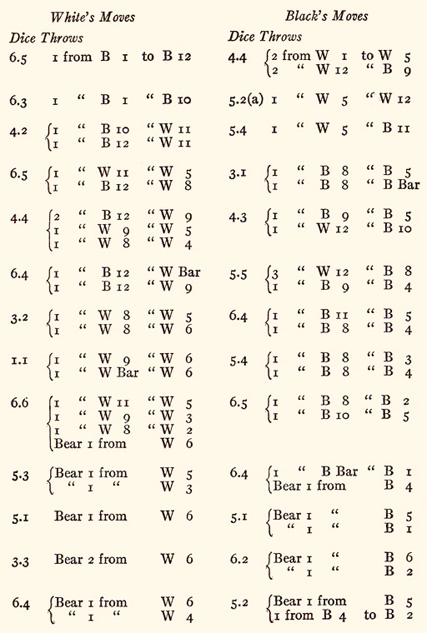
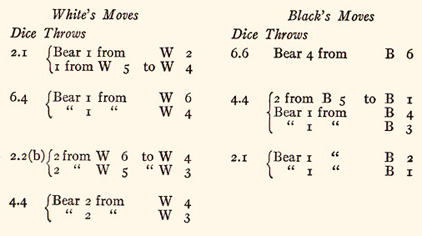
Comments on Running Game
- Black sees that White is starting a running game; since the positions are approximately even, he decides to run too.
- White sees that Black is sure to finish the game in two throws. He therefore makes a move which increases by about 33 per cent his own chances of bearing all four of his men on a single throw. It so happens that this play wins the game for White.
Had White borne one man, two would have remained on his 5-point ; then nothing but double 5’s or 6’s would have enabled him to win.
Blocking Game
Illustrating the Blocking Game at Its Best — a Side Prime
(In the table below, the letters “W” and “B” mean White and Black. For instance, the first move given is from Black’s 12-point to White’s bar-point. Wherever an asterisk (*) appears, it signifies that a man has been hit and sent to the bar.)
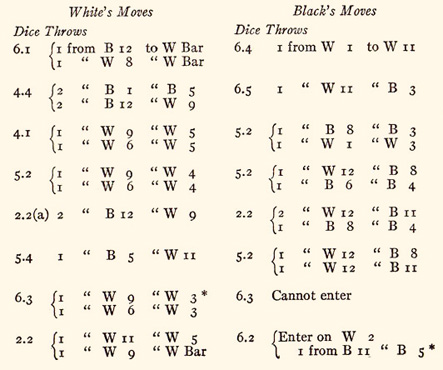
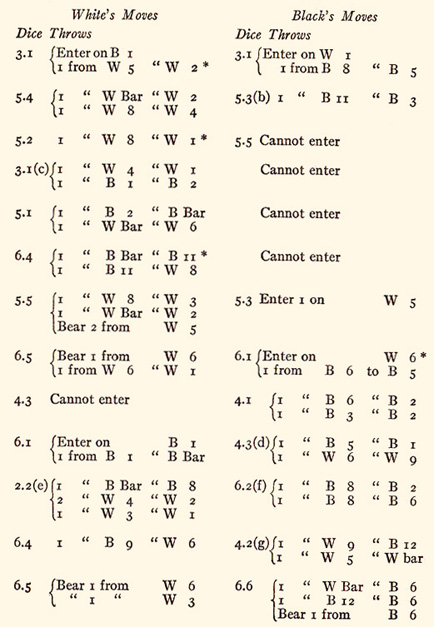
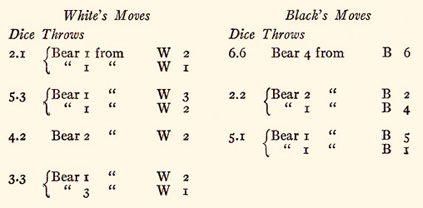
Comments on Blocking Game
- This move completes a side prime for White.
- To send White home would be a mistake; it would delay White’s breaking the side prime and might cause Black to break up his board.
- This move completes a closed board for White, his inner table being entirely filled with his own points.
- To move both men from White’s inner board would be a bad play. The one man moved gives White less chances of hitting one of the two blots and more chances of hitting White’s blot.
- To move the man from Black’s bar more than 2 would bring it within range of a single die and increase greatly the chances of being hit. Moving the man only 2 gives the opponent only a 1-to-5 and a 1-to-17 chance of hitting it, or a combined chance of 1 to 4.
- To move the men on White’s board would lessen the chances of hitting White’s blot.
- This move is made so that a throw of 6 will enable a man to enter the inner table.
Back Game
(In the table below, the letters “W” and “B” mean White and Black. For instance, the first move given is from Black’s 1-point to Black’s bar-point. Wherever an asterisk (*) appears, it signifies that a man has been hit and sent to the bar.)
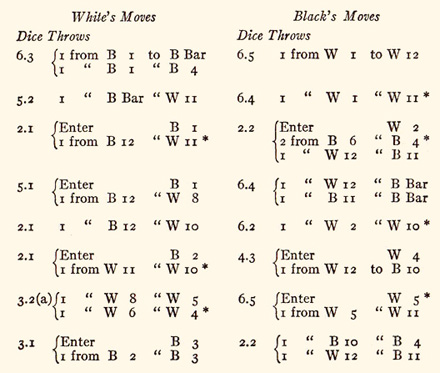
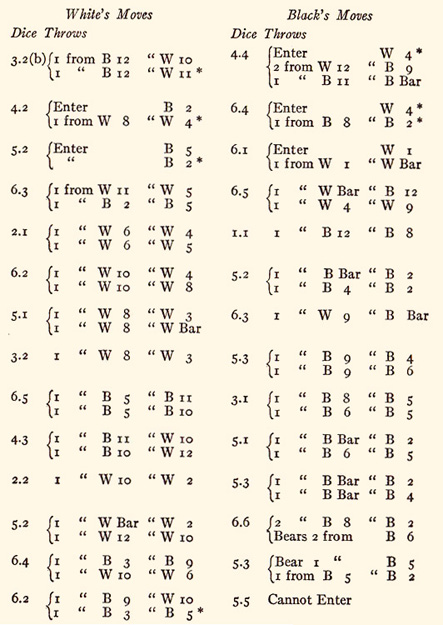
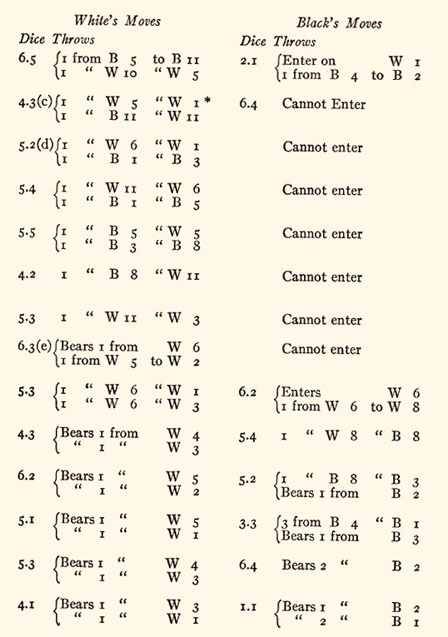

Comments on Back Game
- White sees that a forward game is now hopeless, so definitely decides to resort to a back game.
- White, not wishing to make too much progress, which would diminish the effectiveness of his back game, does everything possible to make blots and force the opponent to send his men home.
- It is vital that White send this man home. Otherwise a combination of the dice containing a 6 will enable Black to escape the blockade with that man and thereby have a greatly increased chance to win the game.
- This move completes a closed board for White, his inner table being completely filled with his own points.
- To bear the man on the 3-point would be unwise. It would entail the danger of leaving a blot if the next throw should be the 6 or 5 doublet.

For Beginners
Equipment
Backgammon is played upon a board or cloth which is divided into four so-called tables. The tables are generally known respectively as White’s inner table, White’s outer table, Black’s inner table and Black’s outer table. Each table contains six long, narrow, triangular-shaped spaces or points colored alternately in contrasting colors, thereby making a total of twelve on each side of the board, or a grand total of twenty-four on the two sides. If properly made, each point should be long enough to hold five men similar to checkers and wide enough for one on each point, plus a little extra space for convenience, so that there may be room for six men abreast on each table. Each table should have an open space between the end of the points on the two opposite sides of the board, to furnish room in which dice may be thrown.
There should be fifteen men similar to checkers in one color, and fifteen in a contrasting color; black and white or black and White generally are used.
The various points at the Black and White sides of the board are numbered on the diagram below, respectively from right to left, from one up to twelve inclusive for ready reference.

There should be two dice boxes. There may be two pairs of dice, or both players may use one pair.
The Game
The Set-Up
The fifteen men of each player are placed on the table as indicated in the diagram, so that the inner tables are nearest the light. White’s men are placed as follows: two on Black’s 1-point, five on Black’s 12-point, five on White’s 6-point and three on White’s 8-point. Black’s men are placed as follows: two on White’s 1-point, five on White’s 12-point, five on Black’s 6-point and three on Black’s 8-point.
Number of Players
Backgammon is played by two persons, if the regular form of the game is the medium of competition. More can play, as described in the laws of “Chouette,” but when this is clone only two are really active, the others only advising, so that in effect it is a two-handed game.
Start of the Game
The players shall each throw a single die. The one throwing the higher number has his choice of the sides of the board and also his choice of color of men. In ensuing games the players retain the same sides and color of men.
The Objective
The winner is the player who first bears all of his men off the board, after first moving them all into his inner table and then off the board as may be permitted by his dice throws.
A Play
After a throw, the caster proceeds to play any of his men the number of points corresponding to the number thrown.
The Moves
Each player moves his men in the direction from the opponent’s inner table to his opponent’s outer table, then into his own outer table and finally to his own inner table, the opponent’s men going in reverse direction. A player may move one man for both units of the throw, granting that it can be legally moved each of the units separately, but it may not be moved the full distance if neither move prescribed by the separate units can be legally made, or the player may move one man according to one of the numbers thrown and another man according to the other number.
Making a Point
When there are two or more men on a single point they are said to make a point. When such exists, the player may play an additional man or men of his own to that point, but the opponent may not.
Leaving a Blot
When a man remains alone on a point it is called a blot. If the opponent plays a man to that point, he is said to hit a blot. The man hit is removed from the table and placed on the bar — the space which divides the inner from the outer table. It must remain there until played into the adversary’s inner table at the next or some later throw, which is called entering. When it is entered, it is placed on the point in the opponent’s inner table corresponding to the number thrown.
Doublet
When two similar numbers of the dice are thrown, called a “doublet,” the thrower plays double what he throws, just as if he were permitted to throw the dice twice in succession and obtained the same throw each time.
Order of Throws
The players throw and play alternately throughout the game.
Void Throw
Any part of a throw which cannot be played because of opponent’s points, is void, but the thrower must play the whole throw if he can.
Entering
Should a player have a man on the bar, he must first enter this man in the opponent’s inner table before any other move can be made. In order to enter, the pips of one of the dice must correspond to a point on the opponent’s inner table that is not occupied by an opponent’s point.
Inability to Enter
A player is not permitted to move any other man while he has a man on the bar. In this situation, if he makes a throw whereby his man, if entering, would land on an opponent’s point, he cannot enter the man, and therefore his entire throw is void. In such a case it is opponent’s next turn to throw, and this may occur on any number of throws in succession if the player is unable to enter his man.
Hitting Several Blots
Two blots, or more, may be hit at once or in successive throws if the numbers thrown enable the player to hit them. It is optional with a player as to whether he hits a blot or not; not compulsory, unless he has no other possible move.
Bearing
As soon as a player has moved all of his men into his inner table, but not before, he has the privilege of taking them off the board, which is called bearing. At that time he may, at his option, either move a man forward or throw off, or both. When throwing any number higher than any point covered, a man from the highest point may be borne off. A player may move a man the distance indicated by either die and throw off with the other if he wishes. Doublets can at times enable a player to bear four men.
Should a player who has begun bearing have one of his men hit on a blot, that man must be placed on the bar, ready to be entered on the opponent’s inner table, and the player cannot bear any more men until the one taken up has reentered his own home table.
Scoring
It is called a Single Game if the defeated opponent has borne one or more of his men off the board; a Gammon or Double Game if the opponent has not borne off a man, and a Backgammon or Triple Game if, when the winner bears his final man, the adversary, having borne none, still has a man on the bar or one in the winner’s inner table. Should the player, once having borne a man, have one of his pieces taken up, he thereafter can lose only a single game, even if he fails to enter a man before the adversary bears all of his.
Automatic Doubles
When a doublet is thrown by the players at the start of the game to decide who plays first, the size of the stake is automatically doubled. If doublets are repeated, the stake is increased in accordance with the options given in the Laws in this book.
Voluntary Doubles
Either player has the privilege, at any time during the game, to double, meaning that he offers to double the value of the stake. If his opponent refuses to accept the double, the game ends immediately with the declarer the winner, on the basis of the stake in force prior to his double. If a double is accepted, the game goes on with a doubled stake; thereafter an additional double can be made only by the opponent of the last previous doubler.
Chouette
When more than two players wish to take part in a game with a single board, one of them competes against the others. It will be found that more than five players make an awkward and unwieldy game, also that three players are the ideal number. At the start each player throws a single die to determine positions — as to which will play against the others, and as to which will be the active representative of his opponents, the others having merely the capacity of advisers or sharers in the gains or losses. (See Laws of Chouette.)

Definitions of Terms
- Automatic Double
- That which occurs when each of the players at the start of the game throws the same number with his single die to determine choice of positions and who shall play first. This automatically doubles the size of the stake.
- Back Game
- A type of tactics in which a player, instead of trying to rush his men forward so that they may be borne off as soon as possible, concentrates upon doing everything possible to delay his own progress, which he does by endeavoring to have his own men sent home and reentered in his opponent’s inner table, making points, so that later they may hit the opponent’s blots.
- Backgammon
- If a player bears off all of his men while the opponent, not having borne off any man, also has a man in the winner’s inner table or on the bar, it is called a Backgammon or Triple Game and the winner scores three times the value of a game.
- Bar
- The space separating the inner and outer tables, running in length from one player’s side of the table to the other’s. This is generally a raised partition.
- Bar-Point
- The first point in the player’s outer table, next to the bar.
- Bearing
- Removing a player’s man from his inner table in accordance with the throws of the dice after all of his men have been moved into his inner table.
- Blot
- A Single man on a point, which is liable to be hit by the opponent’s men, thereby causing it to be removed from the table to the bar, where it must wait until it can be reentered in the opponent’s inner table.
- Board
- The entire surface upon which a game of backgammon is played.
- Booby Point
- The opponent’s bar-point, called the Booby Point because it is a place from which escape with both men is difficult.
- Builder
- Each extra man, in addition to two, on a single point; or a blot which is in a good position to help make a point.
- Chouette
- A form of backgammon in which more than two people play, one of them competing against all of the others, who constitute a team, one of the latter being the active representative and doing the playing for the others, being aided by their advice.
- Closed Board
- A player’s inner table completely filled with six of his own points.
- Dice — Die
- Plural and singular of the cubes used in casting.
- Double
- To increase the stake to twice its immediate previous size.
- Double Game
- See Gammon.
- Doublet
- A throw of the dice in which each die shows the same number as the other.
- End Game
- The last stages of play.
- Enter
- To start a man which has been hit and is on the bar, by entering it in the opponent’s inner table, on the point indicated by the throw of the dice. No other man may be moved by a player while he has any man on the bar. He must first reenter that man before playing any of the others.
- Forward Game
- A style of tactics in which the player is attempting to advance his men as rapidly as he safely can, meantime trying to protect his men by making points wherever advisable, preparatory to choosing a. running game, blocking game or back game.
- Game
- A game is won by the player who bears off all of his men while the opponent still has one or more not yet borne off.
- Gammon
- If all of the men of one side are borne off before any of the opponent’s men have been borne, it is called a Gammon or Double Game, and the winner scores double the value of a game.
- Hit
- The move of a man to a point occupied by an opponent’s blot, which removes the opponent’s man from the table to the bar. If a hit is accomplished by making the move indicated by only one die of a throw, the player may then move that same man according to the balance of the throw.
- Home
- A player’s own inner table.
- Inner Table
- See Table.
- In the Box
- A term used only in Chouette to describe the player who is competing singly against all of the others, who constitute a team.
- Light
- The light — whether daylight or artificial — decides the location of the inner tables, which should be on the side from which the light comes.
- Man
- A checker.
- Outer Table
- See Table.
- Pips
- The spots or numbers on the dice.
- Point
- A narrow triangular-shaped figure on the board, there being six in each of the four tables or twenty-four total, on which the men are placed on each move. Point also is the term used to describe a combination of two or more of a player’s men located on the same point on the board. When two men are moved into such a position, it is called “making a point,” or “establishing a point.” The player can move any of his own men onto a “point” that he is able to, but may not move any onto a “point” established by his opponent.
- Reenter
- See Enter.
- Running Game
- That situation in which all of each player’s men are either past or practically assured of passing all his opponent’s men so that the game simply becomes a race to determine which can bear his men off first.
- Set-Up
- The arrangement of the men at the start of the game.
- Side Prime
- Six successive or immediately adjacent points, anywhere on the board, occupied by points established by the same player.
- Table
- A section of the board. A player’s inner table is that section of the board into which it is necessary to move all of his men before they can be thrown or borne off. The same player’s outer table is directly adjacent on the same side. Opposite a player’s inner table is his opponent’s inner table and opposite his outer table is his opponent’s outer table.
- Triple Game
- See Backgammon.

Laws of Backgammon
1931
Prepared by the Backgammon and
Cards Committee of the
RACQUET AND TENNIS CLUB
New York City
Approved by the Following Clubs
|
The Brook Calumet Cavendish Hope (Prov.) Knickerbocker Knickerbocker Whist The Leash The Links Pacific Union (San Fran.) Philadelphia (Phila.) Piping Rock Pittsburgh (Pittsburgh) |
Racquet (Chicago) Racquet (Phila.) Racquet (St. Louis) Racquet and Tennis Rittenhouse (Phila.) St. Nicholas Tennis and Racquet (Boston) Tuxedo Union University Whist |

LAWS OF BACKGAMMON *
1931
The Game
- The game of Backgammon is played by two persons.
- Thirty men — fifteen of one color and fifteen of another — are used, and are set up as shown below, on a standard board, of four quarters or tables having six points each.
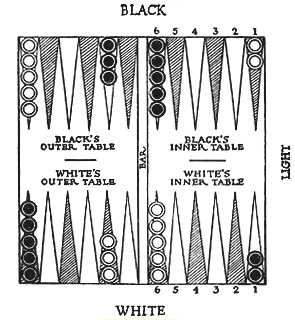
- For entering and throwing off, the points in both inner tables are considered as numbered from 1 to 6, beginning with the point nearest the light.
- Direction of play is from adversary’s inner table to adversary’s outer table, to player’s outer table, and then to player’s inner (home) table.
- Play of the men is governed by two dice, thrown (cast) from a cup in which the dice are shaken before casting.
- Choice of seats, men, set-up, dice, etc., shall be made by the player winning the opening throw.
The Throws
- For the opening throw each player throws a single die. Every tie requires another opening throw. Whoever throws the higher number wins, and for his first move plays the numbers upon both dice. After that each player in turn throws two dice.
- The dice must be rolled together and come to rest flat (not “cocked”) upon the tables at the player’s right, otherwise they must be thrown again.
- If a throw is made before an adversary’s play is completed, or if either player touches a die before it has come to rest, the adversary of the offender may require a rethrow.
- The player must leave his dice upon the board until his play is completed. Should he pick them up or turn them over before the completion of his play, the adversary may declare the play void and require the offender to replace the man or men moved and to throw again.
The Play
- The play of the men consists:
- In moving a man the exact number of points indicated by the number on a die thrown.
- Entering a man, in the adversary’s inner table, on a point corresponding to the number on a die thrown.
- Throwing off (bearing) a man in player’s inner table — when no man is left outside that table or on the bar — from a point corresponding to the number on a die thrown, or as provided in Law 15.
Doublets require four plays — if possible — of the die number thrown.
- In moving a man the exact number of points indicated by the number on a die thrown.
- No play may be made which lands on a point held by two or more of the adversary’s men.
- When a play lands on a single man (blot) of the adversary’s, such man is “hit,” and must be lifted and placed on the bar for entry in the player’s inner table.
- A player having a man on the bar may not play until that man has been entered.
- Plays must be made for both dice if possible. Either number may be played first. If only one number can be played, and there is a choice, the higher must be played.
In throwing off, a man may at all times be correctly thrown off from the highest occupied point which is lower than the number indicated by a die. If a number is thrown for an unoccupied point, no man below can be thrown off, for such number, while any man remains on a higher point.
- Whenever a man has been moved correctly and quitted (the player’s hand removed), that play cannot be changed.
Errors
- If an error has been made in the set-up, either player may correct it prior to the completion of his first play.
- If an error in play has been made, either player may require its correction before a subsequent throw, but not thereafter. The man played in error must be correctly played if possible.
Scoring
- A game is won by the player who first throws off (bears) all of his men.
A Gammon (double game) is won if the adversary has not thrown off a single man. This doubles the count for a single game.
A Backgammon (triple game) is won if the adversary has not thrown off a single man, and has one or more men in the winner’s inner table or upon the bar. This triples the count for a single game.
- Doubling Game. The count is raised: Automatically —
By agreement, each tie of the opening throw may either:
- Double the previous count.
- Add one to the previous count.
Unless an understanding has been reached as to the method and limitation of automatic raises they are not played.
Voluntarily —
Either player may offer the first optional double of the previous count. After that the right to double the previous count alternates, being always with the player who has accepted the last double.
In every case, a double may be offered only when it is the player’s turn to play and before he has thrown the dice. A double may be accepted or declined. The refusal of a double terminates the game, and the player refusing loses whatever his count may amount to at that time. Gammons and Backgammons double or triple the last count.
- Double the previous count.
- By agreement other methods of scoring may be used, such as:
The Point Game. In this 1 point is scored, by the winner of a game, for each man left in the adversary’s inner table; 2 points are scored for each man left in the adversary’s outer table; 3 points for each man left in the winner’s outer table, and 4 points for each man left in the winner’s inner table or upon the bar.

Chouette
- Chouette is played by three or more members.
- In beginning the game each member shall throw a die and the one throwing the highest number is then the “Man in the Box,” the next highest is the “Captain.” The other members, in accordance with each one’s throw, rank below the Captain and succeed him in that order.
- The initial throw shall determine each member’s position, but, in the event of a tie, only those tying throw again for their position. The highest or higher number always has precedence.
- Any applicant to Chouette may be accepted. He becomes the last ranking member in the first game in which he participates.
- After the positions have been determined the Man in the Box and the Captain proceed as in the two-handed game except that all the remaining members are partners of the Captain.
- The Man in the Box plays alone and scores separately with each one of his adversaries. He retains his position until defeated. In such event, he retires as a player and takes his place as last ranking member (unless there be an added member). The Captain then becomes the Man in the Box.
- The Captain may consult with any or all of the partners on any question that may arise in the course of the game. He is, however, the final arbiter, except as hereafter provided. Should he be defeated, he loses his position and takes his place as last ranking member (unless there be an added member). The highest ranking partner then becomes Captain.
- A double offered by either player may be refused by any partner. Each rejector forfeits to the Man in the Box his count previous to the proposed double.
- Should the Captain decline to accept a double offered by the Man in the Box he loses his position, and forfeits to the Man in the Box his count previous to the proposed double.
- When a double has been declined by the Captain, any or all of the other members may accept it. The highest ranking of those accepting becomes Captain until the termination of that game.
- Accepting or declining a double does not change the rank of the member; except that declining by the Captain loses him his position even though the game be eventually won by the accepting members.

Additional Rules
For those players who desire additional thrills, with the opportunity of starting the game with a possible count as high as 4, 8, or 16 instead of 1, a variation of automatic doubles and an addition of optional doubles has been added. Playing this game, however, in no way affects the Laws. The rules notated below have been played universally abroad and widely tested as being the most interesting and fairest form to contestants.
It is hoped for the good of Backgammon that all players desiring a higher count game will adopt the following rules, thereby eliminating the usual confusion when many people play with different rules.
Rules. — To commence the game each player throws two dice. The count is automatically doubled and both players must re-throw:
- When the pips of each player’s dice add to an equal total.
- When either player or both players throw a double. (Both players throwing a double, doubles the count only once.)
Second Throw. — If the second throw is an automatic double the above rule applies again for this throw.
Third Throw. — If the second throw is an automatic double, automatic doubles cease, but the players have the right to an optional double.
Optional Doubles. — (These start the first, second, or third throws according to whether automatic doubles have occurred.)
The player whose dice make the highest total (a double multiplies the total of the pips by two) has the option to —
- Play the throw, in which case the count does not double.
- Throw again, in which case the count is doubled.
The opponent now throws and immediately has the same option (a) or (b).
Players who desire to limit the count of automatic and optional doubles to 8 instead of 16 eliminate the second automatic double.
Players who desire to limit the count to 4 instead of 8 or 16 eliminate automatic doubles and only play the optional doubles.
Thereafter voluntary doubles, redoubles, etc., apply as notated in Laws of Backgammon.

Questions Clarified
Question: When Bearing, can a man be played from a high point to a lower point on one’s board, playing the smaller number of one of the dice first and then the higher number of the other die, to bear a man? Answer: Yes.
Law 11 (c) reads: “Throwing off (bearing) a man in player’s inner table — when no man is left outside that table or on the bar — from a point corresponding to the number on a die thrown, or as provided in Law 15.” Law 15 reads: “Plays must be made for both dice if possible. Either number may be played first. If only one number can be played, and there is a choice, the higher must be played.”
Example: Player has two men on the 2-point, two men on 3-point, one man on 4-point, opponent has a man on player’s 1-point. Player throws 4-1, he may play the man on the 4-point to the 3-point, using the 1 and then take the man off the 3-point using the 4.
Question: Can a player double after throwing the dice and completing his play, if his opponent is unable to play? Answer: Yes.
Law 20 reads in part: “Either player may offer the first optional double of the previous count. After that the right to double the previous count alternates, being always with the player who has accepted the last double. In every case, a double may be offered only when it is the player’s turn to play and before he has thrown the dice.”
Question: Should a player bear a man or men while one of his men is still out of his inner table or on the bar and not be corrected until after the opponent has thrown; are the men or man borne to be reentered or considered as borne? Answer: They remain as borne.
Law 11 (c) reads in part: “Throwing off (bearing) a man in player’s inner table — when no man is left outside that table or on the bar.” Law 18: “If an error in play has been made, either player may require its correction before a subsequent throw, but not thereafter. The man played in error must be correctly played if possible.”
A player bearing while still having a man to enter into his inner table has committed an error. An error may only be corrected by an opponent before a subsequent throw.
Question: Does a “Backgammon” or triple game, double and then double again the final count? Answer: No.
A “Backgammon” means the final count is tripled or multiplied by three. This Law, observed by the foremost players of the game should not be neglected.
Question: Can a player after throwing the dice, which become cocked, double, before throwing again, should it be his turn to double? Answer: No.
Law 20 reads, in part: — “In every case, a double may be offered only when it is the player’s turn to play and before he has thrown the dice.” Law 8 reads: “The dice must be rolled together and come to rest flat (not “cocked”) upon the tables at the player’s right, otherwise they must be thrown again.”
Law 20 allows a double in turn before the dice are thrown. Law 8 forces one throwing dice that are cocked to throw again. The word “again” therefore makes the second throw a continuation of the throw and too late to offer a double.

Tournament Play
Backgammon tournaments are relatively new in this country, though they have been conducted off and on for years in Europe. Many different types of events have been tested, some having proved highly successful and easy to conduct, others not popular because of various reasons. Every style suggested in this chapter has been tried out thoroughly in one circle or another, has been conducted efficiently without undue effort and has been pleasing to those involved.
Among the different kinds of tournaments for which regulations are necessary, to fit varying conditions, are: (1) those of a single afternoon or evening session; (2) club or group championships which require a number of sessions of play; (3) team matches between clubs or other organizations; and (4) league events in which a number of teams compete with one another. Each of these is provided for in what follows: the first kind — one-session event — being covered by two styles of play, known as a North-South Tournament, in which each contestant continues to play from start to finish of the event, and an Elimination Tournament, in which the losers in each round of play are out of the contest. The Round-Robin Tournament described is suited to various conditions.
In all forms of tournaments except elimination events, the best and fairest scoring method is to credit a player with all games won and debit him with all games lost. To count only games won, disregarding games lost, would allow a player to take unwarranted chances of being gammoned or backgammoned with no risk of any penalty.
North-South Tournament
This form of competition has proved by far the most popular kind of one-session event, since it does not force idleness upon those players who may happen to be beaten in early matches. It is conducted similarly to the duplicate bridge tournaments in leading bridge clubs in various parts of the country.
Any even number of players may take part. Half of them are grouped as North players, the other half as South players; each retains his respective side throughout the event. While each North player directly opposes a South player in each game, the South players are not his real opponents. He is really competing against the other North players, to determine which of the North players can make the best record for the session, and in like manner each South player is trying to outdo the other South players. Thus in effect there are two competitions in progress at the same time, one among the North players and one among the South players.
Should there be more than twenty-four contestants the play will last too long for one session. In this event, the total number of players should be divided into two or more sections, each section having a complete tournament as outlined. Then, if desired, the winners can be matched against each other as described below in the methods for deciding ties.
The tables are numbered consecutively from one up. At the start each player is provided with a tally card, arranged as shown below.
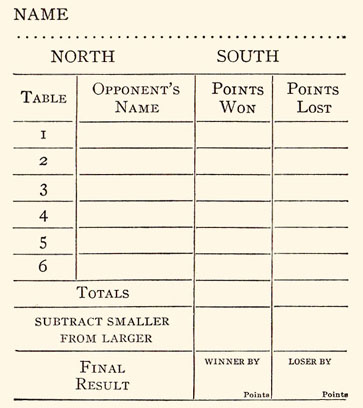
Each player’s name should be written on the top of his card. The “North” should be crossed off of the South players’ cards and the “South” off of the North players’ cards. A circle should be drawn around the number of the table at which the player is scheduled to start. In the scoring columns, both points won and lost at each table are recorded. When a match is about to begin, the opponent’s name should be written next to his number. At the close of the contest, both columns are added. Then the smaller total is subtracted from the larger. The result shows whether the player won or lost, and by how many points.
No automatic doubles. One double and one redouble allowed. Game counts one point. Gammon doubles the count. Backgammon triples the count. Upon completion of a match, the South player stands behind the player at the adjoining table, should that match not be finished, and awaits his next opponent. North players remain seated throughout the tournament. The South player at table one moves to table two, the one at table two moves to table three, and so for all the tables, the one at the highest numbered table moving to table one for the next round. This procedure is followed at the close of each round, until each North player has had one game with each South player, each South player having had one game with each North player.
It is recommended that each player play three games against each opponent. The total net score of the three games against any single opponent to be limited to 14 points.
The net scores of all of the North players are then written on a score-board, and those of the South players on another part of the board. The player with the largest plus among the North players is the winner of the North competition; it none of the North players has a plus score, the one with the smallest minus score is the winner. In like fashion, the player with the best South score is the South winner — the largest plus, if there be any plus score, or the smallest minus if there be no plus score.
Should there be only one prize, then the North and South winners meet in a final match to decide the issue, any agreed number of points. Should there be two prizes, and the North and South winners not agree as to which they will take, they must play to decide the issue.
Should there be a tie between two North players, or two South players, for the high score, they must play a match. Should three players of either North or South tie, a die should be thrown by each to determine which ones meet first in the play-off, those throwing the smallest numbers to meet first and the winner then to play the remaining player for the prize. When four tie, they throw to decide who meets whom in the play-off, the throwers of the largest number meeting and the throwers of the smallest number meeting; winners of those games then to meet in a final match.
Elimination Tournament
This form of one-session tournament is conducted similarly to match play tournaments at golf, tennis and other games, the beaten contestants of each round being eliminated from further play.
The most successful number of entrants in such an event is eight, sixteen or thirty-two, for with these even multiples it is possible to have each player take part in the same number of individual matches. A form should be drawn up along the lines of the following chart:
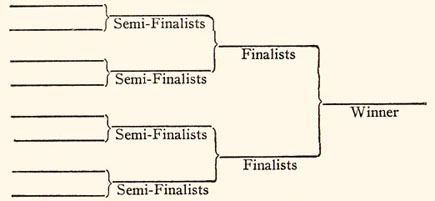
Should there be more than eight players, the form should provide for another round, with space for sixteen names; if there be more than sixteen, then still another round with room for thirty-two, etc. The names of the players should be written on slips of paper, shuffled in a hat or receptacle of some kind, and drawn at random. They are then written in the order drawn on the lines at the left of the chart, in the first round section of it. If there be not quite enough names to fill all the lines, then the last few names to be written are those of players who have no matches to play in the first round, and, in other words, such a player has drawn “a bye.”
The first two players listed meet in the first round of play, the loser being eliminated and the winner’s name being written on the line in the next round, where the winner of some other match, with whom he is now bracketed, becomes his next opponent, and so on until only two remain to take part in the final, the winner of which is the winner of the tournament.
No automatic doubles. One double and one redouble allowed. Game counts one point. Gammon doubles the count. Backgammon triples the count. Each round prior to the finals to be decided on a basis of which player scores 3 points first; each semi-final match to be a contest to determine which player can score 5 points first, and the final to be won by the player scoring 7 points first. These amounts may be changed by agreement to suit the number of players engaged or the length of time available.
When a tournament can be extended over a number of days it is recommended that each match be decided by the player who scores 11 points first, the semi-final 17 points, and the final 25 points.
Round-Robin Tournament
In this type of contest, each player meets each other player in one or more games. If the number of players is small, it is suitable to a single session’s play. In this case, each contestant would play once against each of the others.
No automatic doubles. One double and one redouble allowed. Game counts one point. Gammon doubles the count. Backgammon triples the count. If it be desired to have the event last through several sessions — perhaps involving the entire membership of a club — tw0 or three or even more games may be played in each single contest between any two players.
A chart should be drawn up, similar to the following, with the names of all the players written in the horizontal column at the extreme left, and repeated in the same order at the top of each of the other columns.
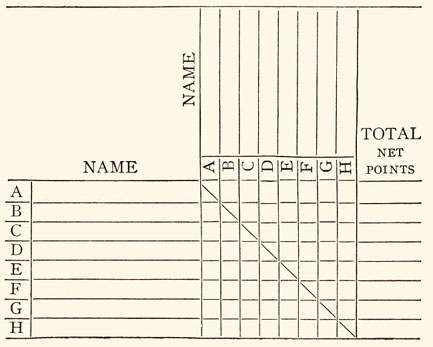
As soon as two players have completed their contest, its score is recorded. The winner records his points won on the horizontal line which bears his name, in the column headed by the player he has defeated. The loser records the same figure, with a minus mark before it (−) on the horizontal line which bears his name, in the column headed by the player who defeated him. If the players contest more than one game and the total result is a tie, a zero is recorded for both.
When the competition is concluded the scores are added. A player’s points lost are deducted from his points won, and the difference between them is his final total point score, in either plus or minus points, showing whether he has won or lost on the entire event, and by how many points.
When this type of event is used for club competition, with a large number of contestants, it is well not to schedule the games at any particular hour. Whenever any two players happen to be present who have not already met each other in the play, they may thereupon play their match and record its score on the blackboard, card, or whatever form of scoring chart is used.
Club or Group Championship
When a season’s competition, in a club or other group, is desired, the simplest form to employ is the elimination event.
No automatic doubles. One double and one redouble allowed. Game counts one point. Gammon doubles the count. Backgammon triples the count. All matches prior to semi-finals to be a test to decide which player first scores 11 points, semi-final games to determine which can first score 17 points, and finals to decide which can first score 25 points. A wise provision, in the interest of keen competition, is this: If two adversaries find themselves tied in a match with only 1 point needed by each to win, extend the game so that the winner will be the one who first scores 2 points additional to those he already has.
Team Matches
When two teams, composed of four, five or six players each, meet, it is best to have each member of one team meet each member of the other team in a match of three games. No automatic doubles. One double and one redouble allowed. Game counts one point. Gammon doubles the count. Backgammon triples the count.
Before starting, the members of one team should receive numbers, from 1 up, and those of the other team letters, from A up. Each player should have a tally card arranged as follows:
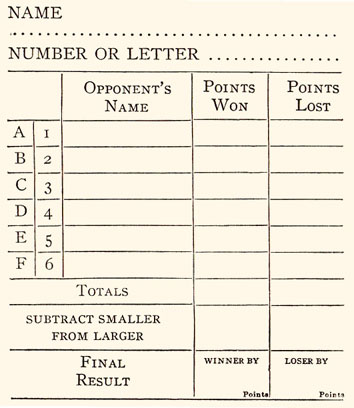
Each player’s name, and his number or letter, should be written at the top of his card. Then, if he is on the numbered team, the column of numbers at the left should be crossed off, leaving the column of letters to indicate his opponents; if on the lettered team, the column of letters should be crossed off, leaving the column of numbers to designate his opponents. A circle should be drawn around the number or letter of the particular opponent against whom he is scheduled to play first. When a match is about to begin, the opponent’s name should be written next to his number or letter.
After each match, the player records its result on his tally and at the close of the entire contest adds and subtracts as explained in the regulations for a North-South Tournament. No player should start a new match until all matches of the preceding round are ended.
At the end of the contest, the plus tallies of a team are added, also its minus tallies, and the difference between the totals shows whether the team won or lost and by how many points.
After the tallies of the two teams have been added, and the subtractions made, the final result for one team must balance that for the other; thus, if one team finishes with a plus score of 7, the other team must have a minus score of 7.
Complete schedules have been worked out, whereby each player of one team meets each member of the other. They are given herewith, letters of course indicating the members of one team and numbers denoting those of the other:
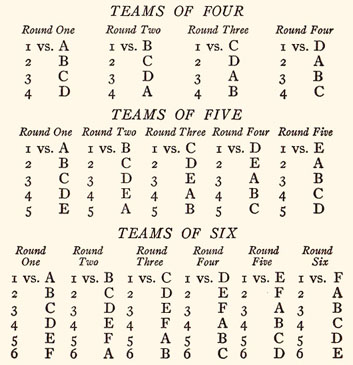
Team matches in which the number 1 man of one team plays the number 1 man of the opponents, the number 2 men likewise meeting, etc., throughout a session, have proved a failure in various respects. To begin with, they are monotonous compared to those in which there are various opponents to meet. There is also the occasional problem of two players who may not get along any too well as companions for an entire evening. There is also a sociability element in favor of the style of event in which one player meets several others during the course of the competition.
Inter-Club Leagues
The most successful way to conduct an interclub league, or any league involving a number of teams, is to have a series of team matches such as those already described, each club to play one match with the team of each other club. The plus or minus score of each team match to be recorded; at the end of the season’s competition, all of a team’s plus scores should be added, also all of its minus scores, and the smaller subtracted from the larger, which would show whether the team attained a plus or minus net score for the season, and how large. The team with the largest plus score for the season would be the winner of the league championship.
The number of players composing a team should be decided upon before the season’s series begins, also the complete schedule for the season, including precise starting hour for matches.
Should a team not be complete at the appointed hour, and the opposing team have enough players ready, the player for whom there is no adversary is awarded 3 points, and the absentee’s card is debited 3 points.
